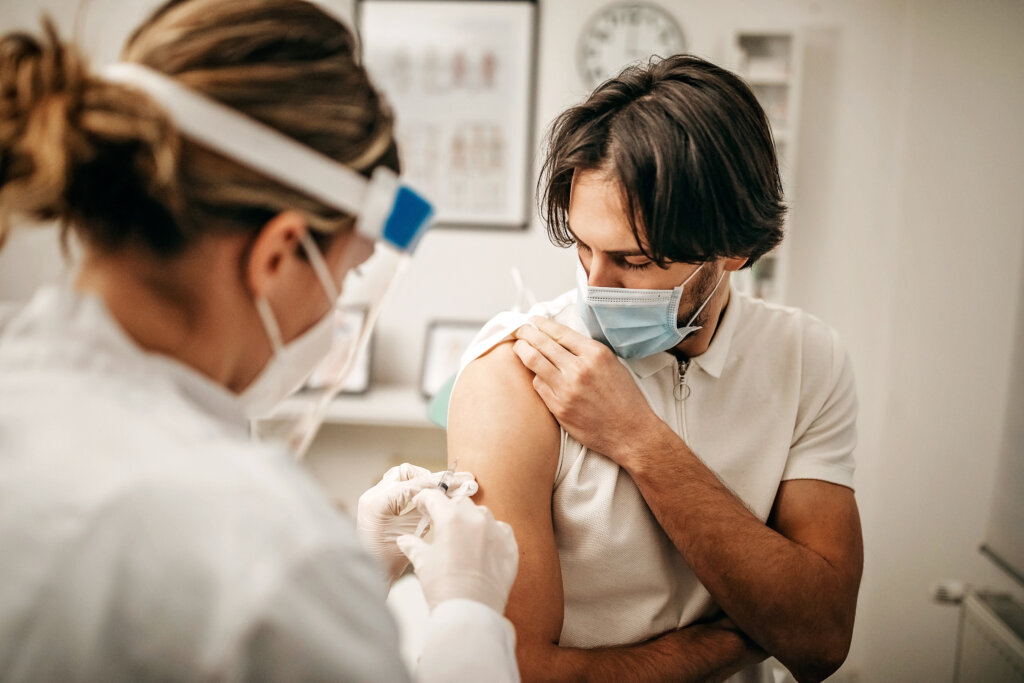Should I wear gloves when I’m vaccinating patients? A Risk Assessment Guide
By: Abigail L. Carlson, MD, and Erica Tindall Umeakunne, MSN, MPH, APRN, AGNP-C, CIC

We’ve gotten a lot of questions about the recommendations for personal protective equipment (PPE) healthcare workers should wear when giving COVID-19, influenza or routine vaccinations.
Centers for Disease Control and Prevention (CDC) recommendations say that gloves are “optional” for subcutaneous or intramuscular vaccinations, which applies to the COVID-19 vaccines that are currently available. So, what do we mean by that?
There are times when you might need gloves, and times when you generally don’t. The key is to assess your situation, and then use your knowledge about infection control actions to decide what steps you should take to protect yourself and your patients.
When not necessary, using gloves can create risks, like contamination, without offering additional protection for you or your patients.
Let’s think through some possible situations you might experience when you’re giving a vaccine, and what might play into your decision to wear gloves or not. Keep in mind that these are just examples.
Instances when you might choose not to use gloves:
- During interactions when you won’t have contact with blood, body fluids or non-intact skin, for example during some vaccinations, or when you’re assessing blood pressure or obtaining vital signs.
- If there’s a possibility you won’t be able to change gloves between each patient. You don’t want to put on a pair of gloves at the beginning of your shift and not take them off until the end of your shift because germs could spread from your dirty gloves to your patients, your coworkers, yourself, and the environment. In this instance, it’s better not to wear gloves at all, and instead much safer to clean your hands between every vaccination and adjust your vaccination practices to prevent contact with blood or body fluids. For example, you could ask your patient to hold gauze over the injection site instead of you.
- During a mass vaccination campaign, when you’re working to vaccinate as many patients as possible, as quickly as you safely can. In this instance quickly removing gloves, cleaning your hands, and putting on a new set of gloves might not allow enough time for your hands to be completely disinfected before moving on to the next patient. Rushing could also lead to mistakes and potential contamination if your gloves are not removed appropriately.
- During times when unnecessary glove use might lead to or worsen shortages. If you’re in an area where supplies of gloves are running low, using gloves when they’re not necessary means that when healthcare workers do need gloves to do their work safely, they may not have enough. When gloves aren’t necessary, cleaning your hands between every patient is the best thing you can do to protect yourself and your patients.
Instances when you may choose to use gloves:
- If you could get blood or body fluid on you, then you want to use gloves to protect yourself. For instance, if you’re going to hold a piece of gauze over the injection site and there’s a chance that the patient’s blood could get on you, like if your patient is on blood thinners or has a clotting problem. In cases like these, because of the chance that there could be blood at the injection site, gloves are a good choice.
- If your own skin is not intact, for example from a cut or eczema, wearing gloves will help keep germs out of your damaged skin, and prevent any germs on your skin from spreading to someone else.
- If your patient has non-intact skin that you need to touch and you don’t have the option to administer the vaccine at a different site on their body, then wearing gloves will help protect you from any germs on their injured skin, and make sure you don’t transfer germs from your hands to their broken skin or to other patients you vaccinate later on.
- If you’re providing vaccination services in a healthcare setting experiencing a COVID-19 outbreak. In this situation, it is more likely that you will encounter patients who are infected with SARS-CoV-2, but who aren’t showing symptoms. The recommended PPE for caring for patients with known or suspected SARS-CoV-2 infection might be used for vaccination in this case and currently includes gloves, gown, eye protection, and a NIOSH-approved N95 or higher respirator, or a facemask if a respirator is not available.
If you work in healthcare, you know that every day is unpredictable. But even if you can’t anticipate everything that might happen, you can still take steps to protect yourself and your patients from the threat of infection by using gloves and other PPE appropriately. You have the power to assess a situation, determine the risk, and act accordingly. CDC’s Project Firstline is here to help you feel confident in applying infection control practices.
For more information about CDC’s Project Firstline, visit their website, or follow them on Facebook or Twitter.
ANA is proud to partner with the CDC for Project Firstline – our interactive series of free online tools to educate nurses about infection prevention and control.



Sorry, the comment form is closed at this time.